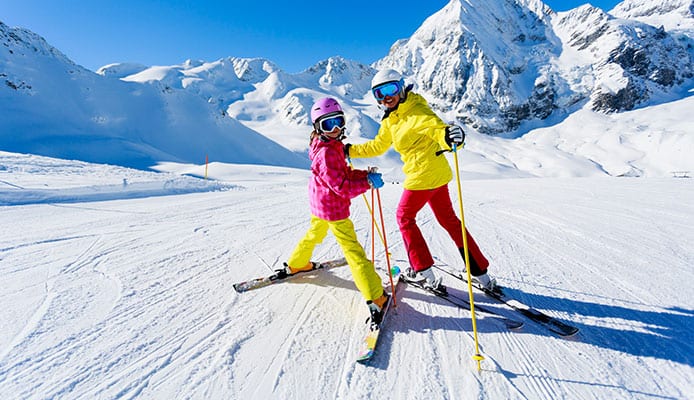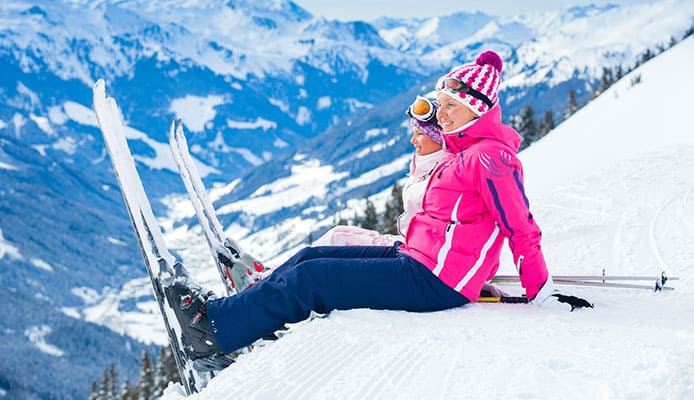
With most sports, you will have only one or two options for how you can go about it. Skiing is quite different – the snow sport features a plethora of styles you can choose from and a wide range of terrains to play on.
Irrespective of whether you are just getting started with skiing or you have been using the all-mountain skis for a long time, keeping track of the different types of skiing can be quite challenging. By showing you the different skiing types, we hope to help you choose a style that works for you. We also hope to help you invest in the right ski gear.
The Different Types of Skiing You May Want to Try
1. Alpine Skiing
Alpine skiing, which is often referred to as downhill skiing, is the most common skiing type. Alpine skiers usually explore pisted valleys and resorts after wearing their skiing jackets. They use gondolas, button lifts, and chairlifts to reach the piste tops.
A lot of skiers prefer to learn how to ski on the piste. The runs are usually graded, from easy to expert. Skiers get to choose the gradient that works best for them.
Alpine skiers usually use ski boots that clip into the alpine ski bindings. These are fixed at the toe and the heel. In the case of a fall, the bindings will eject the boot to prevent leg injuries.
2. Backcountry Skiing
This term is used to refer to different types of skiing that take place in the mountains and not on piste. Since backcountry skiing does not take place in resorts, it may involve hiking up the mountain before you ski down your chosen lines. Some off-piste skiers may choose to use chairlifts to get higher up before deciding to hike outside the resort to ski.
Backcountry skiing can be considered to be one of the most flexible skiing types. This is because the entire mountain range will be a play area for the skier.
After analyzing the avalanche risks and ensuring that everyone in the team is carrying avalanche safety gear, the only limitation backcountry skiers have to deal with is hiking to the top.
The majority of backcountry skiers will prefer to use AT (Alpine Touring) bindings or tech bindings. These allow the heel to remain free while the toe stays attached and hence allowing the skier to walk with the skis. Some ski-tourers may prefer to use skins on the base of the skis – this improves the grip on snow.
3. Cross-Country Skiing
Also referred to as Nordic or XC skiing, cross-country skiing is a skiing type that takes place on flatter terrain. In fact, after donning their ski helmets and ski gloves, cross-country skiers do not go downhill at all. Originally developed as a form of transport, some people still use their cross-country skis to get from one place to the other.
Cross-country skiing features 2 typical styles – these are classic skiing and skate skiing. Below, we will look at the 2 styles of cross-country skiing:
- Classic Skiing – This is a style where the skis always remain parallel when you are kicking and gliding forward. This can be done at a groomed cross-country ski area featuring parallel tracks that the skis can go in. It is also possible to practice classic skiing on ungroomed terrain, including a big open field and forest roads.
- Skate Skiing – This style uses slightly shorter skis than the classic style. To propel yourself forward, you will need to kick the skis out to the side. This is the same thing you would do when ice skating. For efficient movement, you may need to be on a trail that is groomed for skate skiing.
Since cross-country skiing is one of the types of skiing that do not need mountains, it is an ideal sport for people who do not reside near mountains.
The cross-country skiers will use long ski poles to propel themselves along. The bindings and boots used when cross-country skiing allows the heel to be freely lifted.
4. Freestyle Skiing
This is one of the newest skiing types. This type of skiing involves the use of jumps, jibs, rotations, half pipes, etc.
Freestyle skiing is generally a natural evolution of the park and alpine skiing – freestyle skiers usually combine the two. The skiers will use alpine skis and alpine bindings, often featuring twin tips. The tips and tails of the skis are usually turned up to allow the skies to move both forward and backward.
5. Race Skiing

Mogul and slalom ski racing are snow sports that are very common in Europe, although nowadays they are available even in the US. They generally feature short racecourses.
Plenty of ski towns will have their own local teams. Children generally get started with the sport at a young age.
Race skiing is a fun weekend hobby that can help you improve both your control and turns. The majority of slalom skiers will make use of race poles without the powder baskets.
6. Telemark Skiing
Telemark skiing is among the types of skiing featuring numerous similarities to ski-touring. If your goal is to get involved in telemark skiing after donning your skiing goggles, you will need a free heel to make ski-touring possible.
Ski-touring and telemark skiing differ in downhill settings. When moving downhill, telemark skiers will retain a free heel while the ski-tourers usually clip the heel into the bindings, turning them into the downhill bindings.
Tele-skiers ski with one of the skis forward of the other, with the back heel up and the back knee dropped. This is the same technique often used by landing ski jumpers.
You might also like: How To Stop On Skis
7. Ski Mountaineering
This is essentially a subclass of backcountry skiing. It features a focus on reaching the summit of the peak and then skiing back down.
On top of wearing protective gear such as the ski knee braces, ski mountaineers will use alpine touring equipment to travel across the glaciers and snowy slopes. The additional gear that ski mountaineers may need includes boot crampons, ski crampons, rope, and an ice ax.
8. Heli-Skiing
If you feel quite adventurous after donning your ski pants, you can use a helicopter to venture into the wild. Heli-skiing is one of the types of skiing ideal for only professionals. If you have not used your backcountry ski gear for a long time, trying heli-skiing may not be a good idea.
In heli-skiing, you will need to load yourself and all your ski gear into the helicopter and then head up to ride some of the deepest powders you can come across. When choosing the skis to use when heli-skiing, you should pack fat and floaty skis. These should help you stay on top of the snow powder.
9. Alpine Touring
Often referred to as AT for short, this is one of the skiing types classified under backcountry skiing. With alpine touring, you will need some special bindings featuring the ability to switch between fixed-heel and free-heel modes so that you can ascend the slopes with the heels unlocked. You can use climbing skins to improve traction.
When you get to the top of the mountain or hill, you will need to remove the climbing skins, lock your heels back down, and then descend by making parallel turns – the same way you would do when downhill skiing.
Keep in mind that the risk for avalanches is generally high when alpine touring. For this reason, consider learning how to survive an avalanche and also carry an avalanche beacon.
10. Adaptive Skiing
Adaptive skiing makes use of specialized training and equipment to make it possible for people with disabilities to enjoy the full benefits offered by skiing. Different classifications of adaptive skiing do exist, including:
- Two-Track – This is a type of stand-up skiing that does not involve the use of outriggers (outriggers are basically supportive forearm crutches usually attached to ski tips at the point of contact with the snow). Below-knee amputees can participate in two-track adaptive skiing after prosthetic limb advancements.
- Three-Track – In this type of adaptive skiing, 3 contact points exist – the third point is generally a handheld outrigger. This is a common method of skiing for people dealing with single limb weakness. It is also ideal for above-knee amputees.
- Four-Track – 4 points of contact exist. 2 outriggers are usually needed. This adaptive skiing is ideal for people who can stand independently but need 2 outriggers to aid with balance.
- Mono/Bi-Skiing – This involves sit-skiing – the skier will sit on a seat that features 2 skis (bi) or 1 ski (mono). The skiers may use outriggers for balance.
Globo Surf Overview
The great thing about the different types of skiing mentioned above is that most of them are complimentary. This means that if you are visiting a ski town, you can try different skiing types in the same week.
Irrespective of the types of skiing you decide to try, you have to always consider safety. If the skiing type is way out of your skiing experience level, wait until you are experienced enough. You wouldn’t want to return home with injuries.
More Snow Ski Lesson Guides:
- Ski Tricks For Beginners
- How To Jump On Skis
- What Are Skis Made Of: Ski Construction Guide
- How To Ski While It’s Raining
- 3 Ways How To Carry Skis
- How To Get On And Off Ski Lifts
- How Long Is A Ski Season?
- How Much Does It Cost To Ski
- How To Slow Down Skiing
- How To Ski Rails

